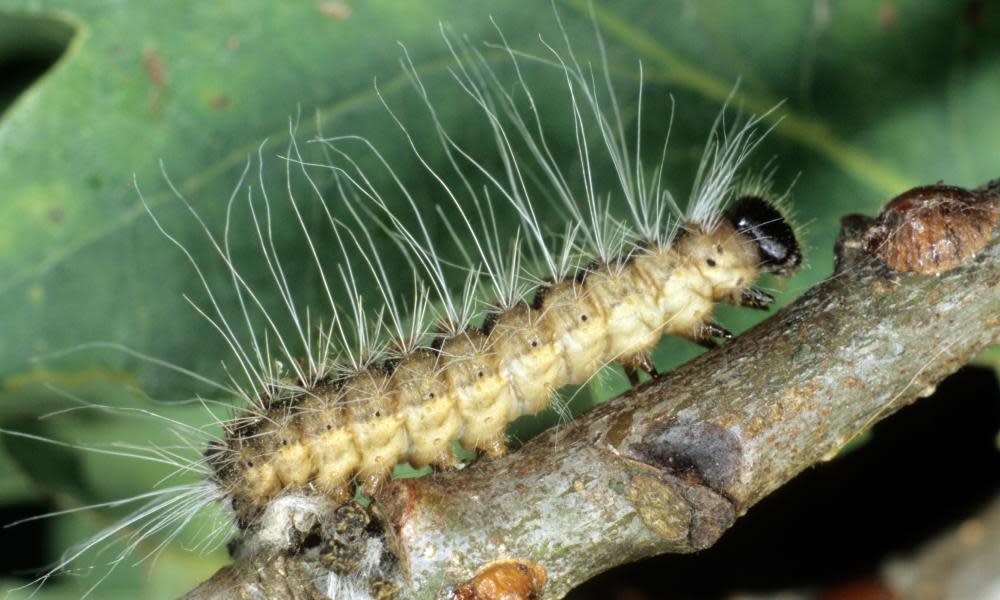Invasive moth species spreading across south-east England, say experts

The government has introduced new legislation controlling the movement of oak trees in south-east England due to a rise in the numbers of a toxic, invasive moth species.
The oak processionary moth was first spotted in Kew Gardens, in south-west London, in 2006 after the eggs were imported on an oak from Europe. The insects, whose caterpillars produce tiny hairs that can cause allergic reactions in humans, feed on the leaves of oak trees.
Tough biosecurity measures, including the swift treatment of outbreaks and a ban on moving oak trees to or from affected areas, meant that at first the moth was mostly confined to the capital. It expanded its range by about two miles a year until 2016, when its spread accelerated to five miles a year and it was spotted outside London, according to the Forestry Commission.
The moth now officially has strongholds in the south-east. The commission has put a buffer zone in place which stretches from Colchester to Oxford and Eastbourne to Southampton, with cases recorded throughout the zone.
In the zone, there will be an annual programme of surveillance and control, which involves detecting the moth and treating infested oak trees, while monitoring trees in close proximity. People who own an infested oak tree in the zone may be issued with a statutory plant health notice, which requires them to take action such as treating and monitoring affected trees and the trees around them.
There is also a ban on the movement of large oak trees from the buffer zone into areas free from the pest, unless the trees have been grown throughout their life in a site with complete physical protection against the oak processionary moth and have been inspected at appropriate times and found to be free of the insects.
The moths’ spread, according to experts, is moving strongly through Surrey and towards Hampshire. Andrew Hoppit, the oak processionary moth project manager at the Forestry Commission, said it had been incredibly difficult to contain cases of the moth, and it was unlikely that its spread would be stopped.
Hoppit told the Times: “It’s a little brown moth which flies at night-time and is jolly difficult to find.” He said the best result would be to “dampen” the rate at which it spreads rather than trying to stop the spread.
The caterpillars are thought of as pests because they feed on the leaves of several species of oak trees, with trees vulnerable to being stripped bare by large populations. This weakens the tree, meaning it could be more affected by other pests and diseases, and more susceptible to other issues including drought.
The insects are hard to spot, as the caterpillars are only about 2mm long when they emerge in spring, and tend to remain high in the trees until they are older and larger. Once they are fully grown, they travel further down, usually moving nose to tail in a procession.
Not only do they affect the health of oak trees, but they can also be harmful to people and animals as their itchy hairs can cause rashes, eye and throat irritation, and in rare cases breathing difficulties. In some cases, they can cause cause severe allergic reactions, with repeated exposure to the moth a risk factor in worsening symptoms.
The main treatment is a pesticide sprayed on trees, but this can harm other insects including useful pollinators. Experts have suggested encouraging the moth’s natural predator, the parasitic fly Carcelia iliaca, by growing plants it likes to feed on such as cow parsley.
Prof Nicola Spence, the UK’s chief plant health officer, said: “Our oak trees are an iconic part of our British landscape. Reporting any sightings of oak processionary moth to the Forestry Commission will minimise the pest’s spread and reduce the damaging impact it poses to tree health.
“The caterpillars and their nests can also cause irritation when touched by members of the public. As such, I would advise that those living in London and the surrounding areas avoid the pest.”

 Yahoo News
Yahoo News 
